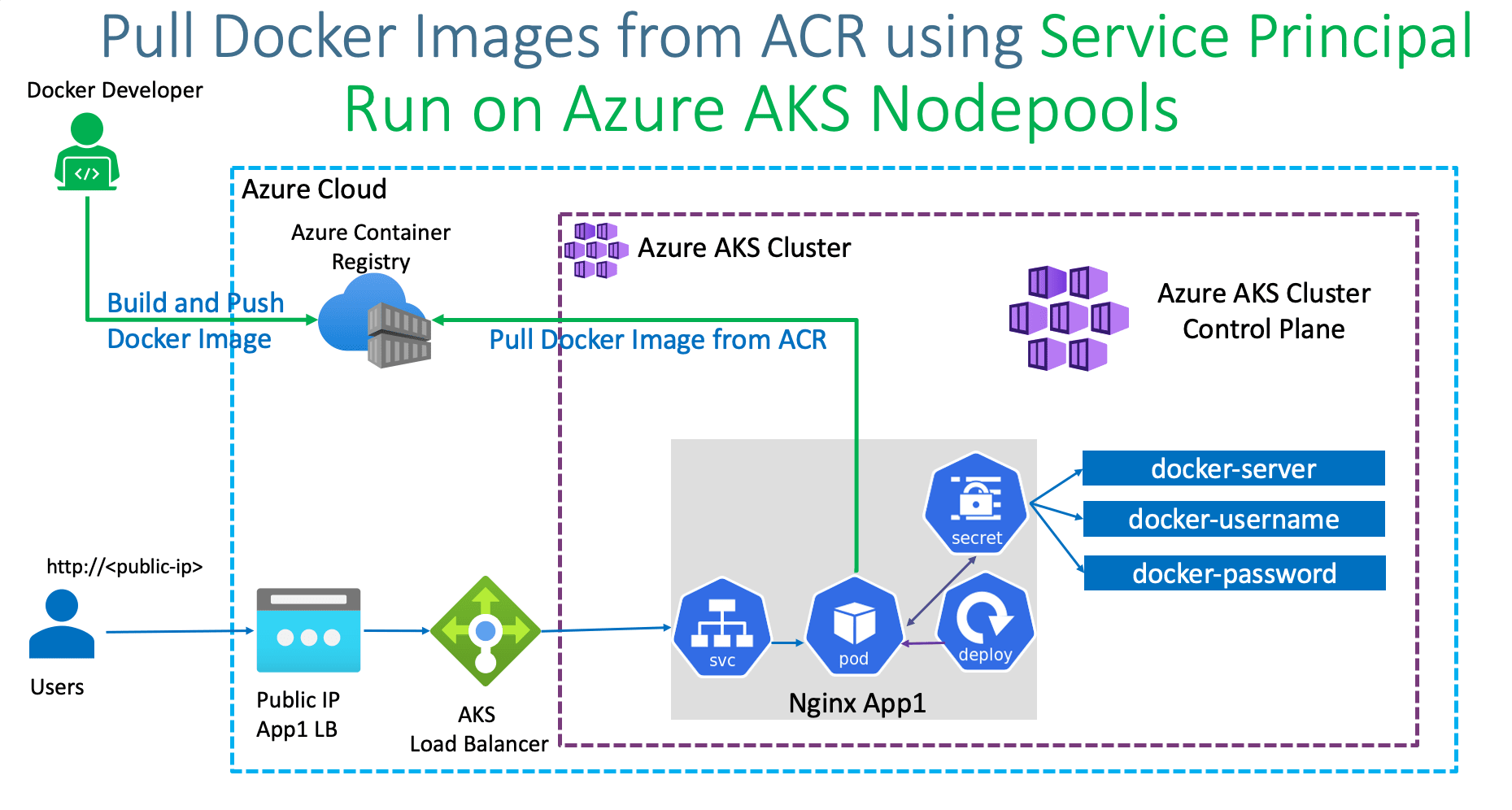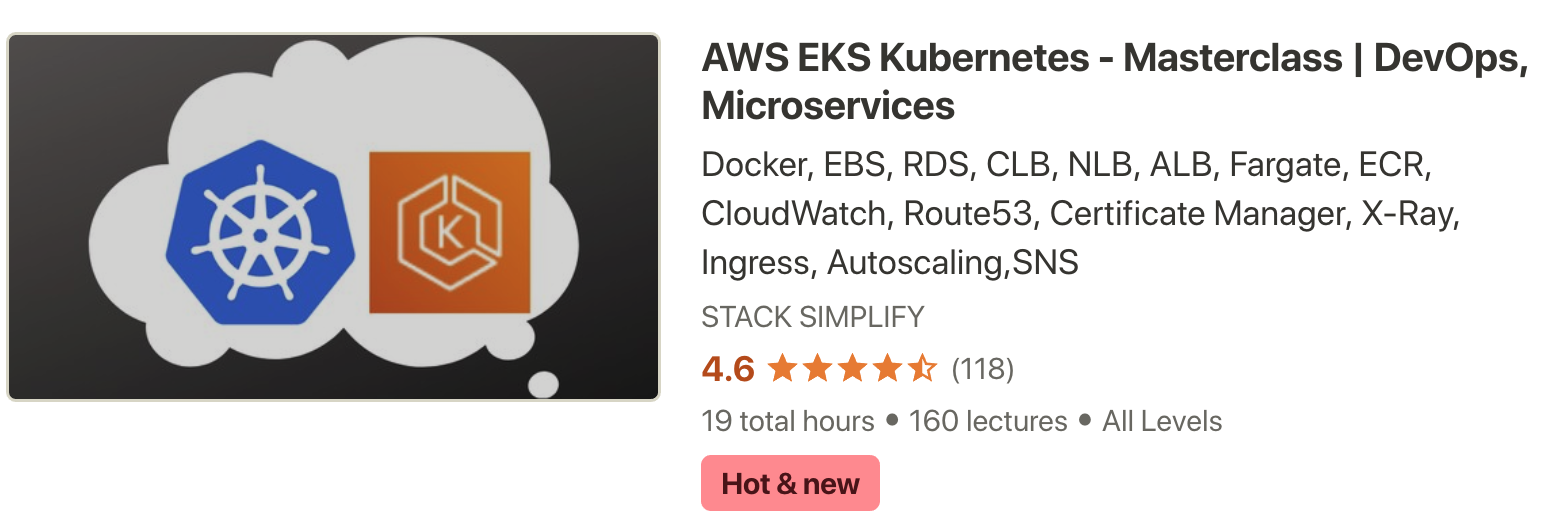Azure AKS Pull Docker Images from ACR using Service Principal Step-00: Pre-requisites We should have Azure AKS Cluster Up and Running. We have created a new aksdemo2 cluster as part of Azure Virtual Nodes demo in previous section. We are going to leverage the same cluster for all 3 demos planned for Azure Container Registry and AKS. # Configure Command Line Credentials
az aks get-credentials --name aksdemo2 --resource-group aks-rg2
# Verify Nodes
kubectl get nodes
kubectl get nodes -o wide
# Verify aci-connector-linux
kubectl get pods -n kube-system
# Verify logs of ACI Connector Linux
kubectl logs -f $(kubectl get po -n kube-system | egrep -o 'aci-connector-linux-[A-Za-z0-9-]+') -n kube-system
Step-01: Introduction We are going to pull Images from Azure Container Registry which is not attached to AKS Cluster. We are going to do that using Azure Service Principals. Build a Docker Image from our Local Docker on our Desktop Push to Azure Container Registry Create Service Principal and using that create Kubernetes Secret. Using Kubernetes Secret associated to Pod Specificaiton, pull the docker image from Azure Container Registry and Schedule on Azure AKS NodePools
VIDEO Step-02: Create Azure Container Registry Go to Services -> Container Registries Click on Add Subscription: StackSimplify-Paid-Subsciption Resource Group: acr-rg2 Registry Name: acrdemo2ss (NAME should be unique across Azure Cloud) Location: Central US SKU: Basic (Pricing Note: $0.167 per day) Click on Review + Create Click on Create Step-02: Build Docker Image Locally # Change Directory
cd docker-manifests
# Docker Build
docker build -t acr-app2:v1 .
# List Docker Images
docker images
docker images acr-app2:v1
Step-03: Run locally and test # Run locally and Test
docker run --name acr-app2 --rm -p 80:80 -d acr-app2:v1
# Access Application locally
http://localhost
# Stop Docker Image
docker stop acr-app2
Step-04: Enable Docker Login for ACR Repository Go to Services -> Container Registries -> acrdemo2ss Go to Access Keys Click on Enable Admin User Make a note of Username and password Step-05: Push Docker Image to Azure Container Registry Build, Test Locally, Tag and Push to ACR # Export Command
export ACR_REGISTRY=acrdemo2ss.azurecr.io
export ACR_NAMESPACE=app2
export ACR_IMAGE_NAME=acr-app2
export ACR_IMAGE_TAG=v1
echo $ACR_REGISTRY, $ACR_NAMESPACE, $ACR_IMAGE_NAME, $ACR_IMAGE_TAG
# Login to ACR
docker login $ACR_REGISTRY
# Tag
docker tag acr-app2:v1 $ACR_REGISTRY/$ACR_NAMESPACE/$ACR_IMAGE_NAME:$ACR_IMAGE_TAG
It replaces as below
docker tag acr-app2:v1 acrdemo2ss.azurecr.io/app2/acr-app2:v1
# List Docker Images to verify
docker images acr-app2:v1
docker images $ACR_REGISTRY/$ACR_NAMESPACE/$ACR_IMAGE_NAME:$ACR_IMAGE_TAG
# Push Docker Images
docker push $ACR_REGISTRY/$ACR_NAMESPACE/$ACR_IMAGE_NAME:$ACR_IMAGE_TAG
Verify Docker Image in ACR Repository Go to Services -> Container Registries -> acrdemo2ss Go to Repositories -> app2/acr-app2 Step-05: Create Service Principal to access Azure Container Registry Review file: shell-script/generate-service-principal.sh Update ACR_NAME with your container registry name Update SERVICE_PRINCIPAL_NAME as desired #!/bin/bash
# Modify for your environment.
# ACR_NAME: The name of your Azure Container Registry
# SERVICE_PRINCIPAL_NAME: Must be unique within your AD tenant
#ACR_NAME=<container-registry-name>
ACR_NAME = acrdemo2ss
SERVICE_PRINCIPAL_NAME = acr-sp-demo
# Obtain the full registry ID for subsequent command args
ACR_REGISTRY_ID = $( az acr show --name $ACR_NAME --query id --output tsv)
# Create the service principal with rights scoped to the registry.
# Default permissions are for docker pull access. Modify the '--role'
# argument value as desired:
# acrpull: pull only
# acrpush: push and pull
# owner: push, pull, and assign roles
SP_PASSWD = $( az ad sp create-for-rbac --name http://$SERVICE_PRINCIPAL_NAME --scopes $ACR_REGISTRY_ID --role acrpull --query password --output tsv)
SP_APP_ID = $( az ad sp show --id http://$SERVICE_PRINCIPAL_NAME --query appId --output tsv)
# Output the service principal's credentials; use these in your services and
# applications to authenticate to the container registry.
echo "Service principal ID: $SP_APP_ID "
echo "Service principal password: $SP_PASSWD "
Step-06: Create Image Pull Secret # Template
kubectl create secret docker-registry <secret-name> \
--namespace <namespace> \
--docker-server=<container-registry-name>.azurecr.io \
--docker-username=<service-principal-ID> \
--docker-password=<service-principal-password>
# Replace
kubectl create secret docker-registry acrdemo2ss-secret \
--namespace default \
--docker-server=acrdemo2ss.azurecr.io \
--docker-username=80beacfe-7176-4ff5-ad22-dbb15528a9a8 \
--docker-password=0zjUzGzSx3_.xi1SC40VcWkdVyl8Ml8QNj
# List Secrets
kubectl get secrets
Step-07: Review, Update & Deploy to AKS & Test Update Deployment Manifest with Image Name, ImagePullSecrets spec :
containers :
- name : acrdemo-localdocker
image : acrdemo2ss.azurecr.io/app2/acr-app2:v1
imagePullPolicy : Always
ports :
- containerPort : 80
imagePullSecrets :
- name : acrdemo2ss-secret
Deploy to AKS and Test # Deploy
kubectl apply -f kube-manifests/
# List Pods
kubectl get pods
# Describe Pod
kubectl describe pod <pod-name>
# Get Load Balancer IP
kubectl get svc
# Access Application
http://<External-IP-from-get-service-output>
Step-07: Clean-Up # Delete Applications
kubectl delete -f kube-manifests/
References



